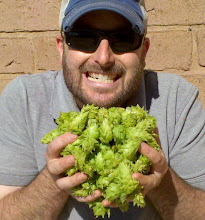 Beer is on its way, my friends!
Beer is on its way, my friends!I had a hANCHORing for a steam beer and it just so happens that house temperatures are ideal right now for fermenting this style. Michelle and I and our friend Kara have had a number of Anchor Brewing beers in the past few months and it reminded me of how much I truly enjoy their Steam® beer (that's right, the descriptor "steam" is a registered trademark by Anchor Brewing and thus the universal style is named California Common rather than a steam beer). I've brewed a handful of beers in this style in the past and you just can't go wrong! I spent the last two weeks dreaming of how I want this beer to be brewed (a clear sign of a serious homebrewing problem!) with the current storehouse availability.
In other news... The state of the kegerator is in recovery mode ever since the mass consumption that took place over New Year's. Currently on tap is the Agave Smoked Porter and the two versions of the Mayahuel Mild. The porter is already running low after bottling-out and a surge of consumption from the recent homebrew drought. The milds were also bottled-out for our club-only session challenge competition as well as to share with Larry at Cantina Mayahuel this coming Monday. Though in recovery, the kegerator is calling, "Feed me, Seymour!" I've realized that I need to start doing 10 gallon batches in the future just to keep up with the local consumption.
While in Big Bear I did manage to bottle out some of the homebrews to share with QUAFF and for the upcoming AFC Homebrew Competition. This past Tuesday, I shared a few beers with my fellow QUAFFers, the infamous Blueberry Wheat, Winter Warmer, and the recent Agave Smoked Porter. I've been genuinely enjoying sharing my beers at our club meetings. While it seems to be easy to please friends, it is the comments and appreciation from fellow homebrewers that is most gratifying.
California Common, January 30 2010
5 Gallons, All Grain, Single Infusion Mash, 90 Minute Boil
8 lbs. Maris Otter Pale
1 lb. Crystal 20
1/2 lb. Victory
1/4 lb. Biscuit
1/4 lb. Caravienne
Single Infusion Mash at 148°F
1 oz. Homegrown Vojvodina hops for 60 min.
1 oz. Spalt for 20 min.
1 Whirlfloc tab 20 min.
1/2 oz. Hallertauer for 10 min.
1/2 oz. Saaz for 10 min.
1/4 oz. Hallertauer for 5 min.
1/4 oz. Saaz for 5 min.
White Labs WLP810 San Francisco Lager Yeast (vial to starter), thanks Kara!
OG: 1.062 @ 66°F
FG: 1.014 @ 42°F
Kegged on March 8th, ABV 6.5%
*some bottled for sharing on March 17th, damn its good!
In other news... The state of the kegerator is in recovery mode ever since the mass consumption that took place over New Year's. Currently on tap is the Agave Smoked Porter and the two versions of the Mayahuel Mild. The porter is already running low after bottling-out and a surge of consumption from the recent homebrew drought. The milds were also bottled-out for our club-only session challenge competition as well as to share with Larry at Cantina Mayahuel this coming Monday. Though in recovery, the kegerator is calling, "Feed me, Seymour!" I've realized that I need to start doing 10 gallon batches in the future just to keep up with the local consumption.
While in Big Bear I did manage to bottle out some of the homebrews to share with QUAFF and for the upcoming AFC Homebrew Competition. This past Tuesday, I shared a few beers with my fellow QUAFFers, the infamous Blueberry Wheat, Winter Warmer, and the recent Agave Smoked Porter. I've been genuinely enjoying sharing my beers at our club meetings. While it seems to be easy to please friends, it is the comments and appreciation from fellow homebrewers that is most gratifying.
California Common, January 30 2010
5 Gallons, All Grain, Single Infusion Mash, 90 Minute Boil
8 lbs. Maris Otter Pale
1 lb. Crystal 20
1/2 lb. Victory
1/4 lb. Biscuit
1/4 lb. Caravienne
Single Infusion Mash at 148°F
1 oz. Homegrown Vojvodina hops for 60 min.
1 oz. Spalt for 20 min.
1 Whirlfloc tab 20 min.
1/2 oz. Hallertauer for 10 min.
1/2 oz. Saaz for 10 min.
1/4 oz. Hallertauer for 5 min.
1/4 oz. Saaz for 5 min.
White Labs WLP810 San Francisco Lager Yeast (vial to starter), thanks Kara!
OG: 1.062 @ 66°F
FG: 1.014 @ 42°F
Kegged on March 8th, ABV 6.5%
*some bottled for sharing on March 17th, damn its good!




























